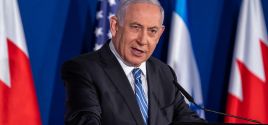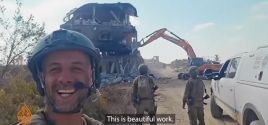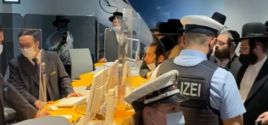Rumsfeld “ordered torture” at Abu GhraibDemocracy NowOct. 27, 2005 |
Popular 
Netanyahu Won't Commit to Not Striking Iranian Nuclear or Oil Sites But Will 'Consider' U.S. Warnings

'The First Live-Streamed Genocide': Al Jazeera Documentary Exposes Israeli War Crimes in Gaza

WashPo: Netanyahu Tells U.S. That Israel Will Not Strike Iranian Nuclear or Oil Sites

Bill Kristol: My Fellow White Americans Are 'The Enemy'

Lufthansa Fined Record $4M for Alleged 'Discrimination' Against Jewish Passengers
 Speaking to 'Democracy Now', Brig. Gen. Janis Karpinski, former military police commander at the centre of the Iraqi prisoner scandal, published a book, "One Woman’s Army: The Commanding General of Abu Ghraib Tells Her Story", in which she described her experience at the Iraqi prison. Karpinski, the highest-ranking officer demoted in connection with the abuse scandal, has admitted she violated the Geneva Conventions, however she said that part of the blame "Goes All the Way to The Top”, stated democracynow.org. The abuse scandal first broke out in April 2004, when photographs depicting the sexual abuse and torture of naked Iraqi detainees were released by the world media, sparking outrage worldwide. Karpinski said that military intelligence took over part of the Abu Ghraib jail to "Gitmoize" their interrogations, in other words, applying methods and tactics used at the U.S. detention center at Guantanamo Bay, Cuba. Karpinski, who said she was being made a "convenient scapegoat" for abuse ordered by top-ranking officials, called on holding Donald Rumsfeld, Lt. Gen. Ricardo Sanchez, Alberto Gonzalez and Maj. Gen. Geoffrey Miller accountable for what happened. AMY GOODMAN: “Today, Janis Karpinski joins us for the hour here on Democracy Now! And she has just published a book about her experience. It's called One Woman's Army: The Commanding General of Abu Ghraib Tells Her Story. Colonel Janis Karpinski, welcome to Democracy Now!” COL. JANIS KARPINSKI: “Good morning. Glad to be here. “ AMY GOODMAN: “It’s good to have you with us. How did you end up at Abu Ghraib?” COL. JANIS KARPINSKI: “Abu Ghraib was one of 17 prison facilities that we were responsible for in Iraq. The units deployed from January throughout 2003 up ’til about April of 2003 to conduct a prisoner of war mission. The units are trained to do prisoner of war operations, and a prisoner of war camp was established in Iraq, very close to the Kuwait border. So, the units -- the unit members, the soldiers, all believed that they were going to come home after victory was declared on the First of May when the President arrived on the aircraft carrier. They allowed me to deploy to Iraq to join my units, to take command of the units, although I was told that the majority of the units, the soldiers, would be coming back home because the mission was complete. “ “When I arrived in Kuwait, I was told that the units were going to be staying for an additional two months, because we were assigned a new mission for prison restoration and training, assisting the prison's experts up at Ambassador Bremer's headquarters in Baghdad, with training Iraqi guards to conduct prison and detention operations. So we relocated. There was never any discussion about whether we were properly equipped or prepared to take on this mission. It was simply assigned to us, and very quickly the two-month extension became a four-month extension, and then it became 365 days, boots on the ground, for all of the units that were deployed. “ “So, soldiers were sent to war with the full expectations that they would be home in six months or less, as they were repeatedly told at the mobilization stations in the United States, and once they were there, they couldn't get out. The extension took them six additional months, tremendous impact on reserve and National Guard soldiers, in particular, but nonetheless, this was the mission. They went forward to different locations in Iraq and took on this new detention operation -- mission. “ “Abu Ghraib was the largest of our facilities. It was located in the Sunni Triangle. It was never a good location for any kind of detention operations, let alone the largest detention operation and then, subsequently, the interrogation center for Iraq. We were being mortared every night at that location. We received no combat support for force protection to prevent any of those attacks from occurring, and the unit that was out there doing that mission, that particular mission at Abu Ghraib, was not equipped with any kind of combat platforms to give adequate protection to prisoners or soldiers.” AMY GOODMAN: “How many M.P.s, military police, were under your command? “ COL. JANIS KARPINSKI: 3,400 soldiers were under the 800th Military Police Brigade, and probably 2,400 of them, 2,500 of them were military police personnel. “ AMY GOODMAN: “And how many prisoners were there? “ COL. JANIS KARPINSKI: “At Abu Ghraib alone, the prisoner population did reach over 7,000 by the end of -- nearing the end of 2003, but we processed over 40,000 prisoners during the course of the time that the 800th M.P. Brigade was responsible for prisoner operations. “ AMY GOODMAN: “Talk about General Miller. Who is he?” COL. JANIS KARPINSKI: “General Miller was sent to visit Iraq by Secretary Rumsfeld and the Undersecretary Cambone. And they came -- General Miller came to visit from Guantanamo Bay. He was the commander of detention operations at Guantanamo Bay, Cuba, and he was sent to assist the military intelligence interrogators with enhancing their techniques. And he brought with him the techniques that were tested and in use at Guantanamo Bay. And he brought a team of about 20 people, 22 people with him to discuss all aspects of interrogation operations, and actually, he did an in-brief. I was invited to participate or to attend to listen to his in-brief, because he was working almost exclusively with the military intelligence people and the military intelligence interrogators while he was there.” “But we owned the locations that he was going to visit, and he ultimately selected Abu Ghraib to be the focus of his efforts, and he told me that he was going to make it the interrogation center for Iraq. He used the term, he was going to “Gitmo-ize” the operation and use the M.P.s to assist the interrogators to enhance interrogations and to obtain more actionable intelligence. “ AMY GOODMAN: “What about the dogs? Is that when the dogs were introduced? “ COL. JANIS KARPINSKI: Shortly after his visit, he -- again, he was spending most of his time with the commander of the Military Intelligence Brigade, Colonel Pappas. In his in-brief, his introduction when he first arrived there with his team, he responded to one of the interrogators, the military interrogator's question, and he was listening to the comments, the criticisms that they were doing these interviews and they were not obtaining really valuable information, so he was there to assist them with different -- implementing different techniques to get more actionable intelligence. And one of the interrogators just asked the question about what he would recommend that they could do immediately, because they thought that they were doing a pretty good job with identifying the people who may have additional value or more military intelligence value, and General Miller said -- his first observation was that they were not -- they were being too nice to them. They were not being aggressive enough. And he used the example at Guantanamo Bay that the prisoners there, when they're brought in, that they're handled by two military policemen. They're escorted everywhere they go -- belly chains, leg irons, hand irons -- and he said, “You have to treat them like dogs.” AMY GOODMAN: “Now, Colonel Pappas ran the prison within the prison, is that right? He ran something called the “hard site”?” COL. JANIS KARPINSKI: “He ran the interrogation operations within the prison, that's correct. And it was -- Cell Block 1A and 1B were the two maximum security wings of the hard site, and during General Miller's visit, either at his order or at his request, General Miller told -- instructed Colonel Pappas to get control of Cell Block 1A. “ AMY GOODMAN: “Treat the prisoners like dogs. That explains the leashes and making prisoners bark?” COL. JANIS KARPINSKI: “It seems to be consistent with those photographs, yes, with the dog collar, the dog leash and un-muzzled dogs. And, in fact, those techniques have appeared in several memorandums that have been signed by senior people.” AMY GOODMAN: “When did you start to understand what was happening?” COL. JANIS KARPINSKI: “About the situation at Abu Ghraib, I was first informed by an email that I received on classified – what they call “classified traffic.” I opened it up late one night on the 12th of January of 2004. And it was from the commander of the Criminal Investigation Division. He sent me an email and said, “Ma'am, I just want to make you aware, I'm going in to brief the C.G.,” meaning General Sanchez, “on the progress of the investigation at Abu Ghraib. This involves the allegations of abuse and the photographs.” That was the first I heard of it. “ “I did not receive that email or phone call or a message from General Sanchez himself, who would ultimately attempt to hold me fully responsible for this, but from the C.I.D. Commander. And I was alarmed at just that short email. I was not in Baghdad at the time. I was at another location very close to the Iranian border, so we made arrangements to leave at the crack of dawn to drive down to Abu Ghraib to see what we could find out about this ongoing investigation and went through the battalion over to Cell Block 1A. The people who would normally be working on any shift were not working. The sergeant that I spoke to said that their records had been seized by the investigators, and they started a new log to account for prisoners, make sure that their meals were on time, those kind of things, and he pointed out a memo that was posted on a column just outside of their small administrative office. And the memorandum was signed by the Secretary of Defense, and – AMY GOODMAN: “By Donald Rumsfeld.” COL. JANIS KARPINSKI: “By Donald Rumsfeld. And said – it discussed interrogation techniques that were authorized. It was one page. It talked about stress positions, noise and light discipline, the use of music, disrupting sleep patterns, those kind of techniques. But there was a handwritten note out to the side. And this was a copy. It was a photocopy of the original, I would imagine. But it was unusual that an interrogation memorandum would be posted inside of a detention cell block, because interrogations were not conducted in the cell block.” AMY GOODMAN: “This was the command of Donald Rumsfeld himself?” COL. JANIS KARPINSKI: “Yes. “ AMY GOODMAN: “Talking about the techniques?” COL. JANIS KARPINSKI: “The techniques that were allowed. And there was a note – handwritten note out to the side of where the list of tactics, interrogation tactics were. It said, "Make sure this happens." And it seemed to be in the same handwriting as the signature. That's what I could say about the memorandum.” AMY GOODMAN: “People understood it to be from Rumsfeld?” COL. JANIS KARPINSKI: “Yes, they certainly did. And I never heard a word – I did – certainly did see the reference to photographs in the original email, but when I asked the soldier, when I asked the sergeant, when I asked the commanders out at Abu Ghraib, what did they know about, they knew nothing about it. They had heard that there were some photographs, but they did not know any specifics.” AMY GOODMAN: The Geneva – the ghost detainees, is this the only time you believe you broke the Geneva Conventions? COL. JANIS KARPINSKI: Well, I will tell you that all of the prison facilities were right on the line, not in terms of how the prisoners were being treated, but the conditions were very austere. We were keeping prisoners in the outside camps only for as long as we needed to because the temperatures were 120 degrees, 140 degrees by noontime, so I would say that we were very close to being in violation of fair treatment and humane treatment of detainees. AMY GOODMAN: Did you ever speak directly to Donald Rumsfeld? COL. JANIS KARPINSKI: “No, I – Yes, he came to visit, and I expressed my concerns about the conditions in the prisons. I spoke directly to Ambassador Bremer nearly every week. I spoke to General Sanchez at least once every week, reported it in the updates and the night time briefings to General Wojdakowski, who was the deputy at CJTF-7, about the lack of funding, even the basic supplies: a basin for washing, a change of clothing, and the funding that was supposed to come from the prisons department at Ambassador Bremer's headquarters. We never saw one-tenth of the funds that we were supposed to receive. “ |



